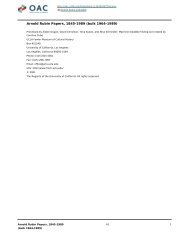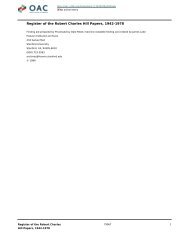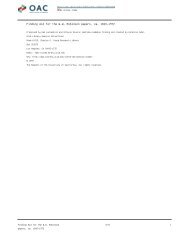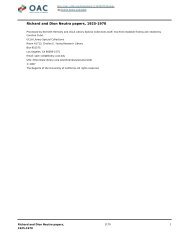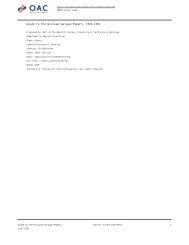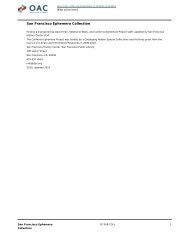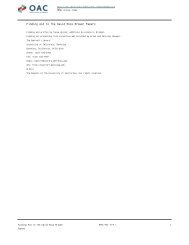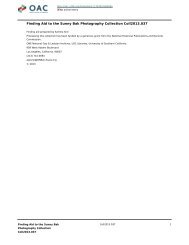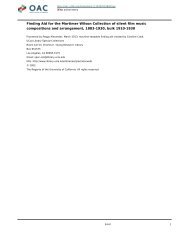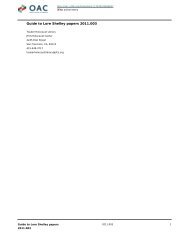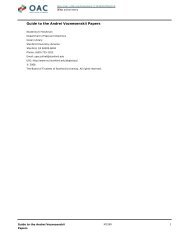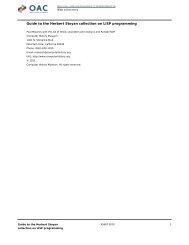Ernest J. Kump collection - OAC PDF server
Ernest J. Kump collection - OAC PDF server
Ernest J. Kump collection - OAC PDF server
You also want an ePaper? Increase the reach of your titles
YUMPU automatically turns print PDFs into web optimized ePapers that Google loves.
<strong>Kump</strong> formed <strong>Ernest</strong> <strong>Kump</strong> Associates in 1955 with offices in Palo Alto and New York. During this period he designednumerous educational buildings in California, including the much lauded Foothill College (with Peter Walker, landscapearchitect), De Anza College, and Crown College, University of California, Santa Cruz Other designs of recognition include theU.S. Embassy in Seoul, Korea and the Pacific Lumber Company Headquarters in San Francisco. In 1990, he partnered withHiko Takeda to research and develop<strong>Kump</strong> was part of the Master Planning Committee at the University of California, Santa Cruz (UCSC), starting in 1961 withTheodore Bernardi, Robert Anshen, John Carl Warnecke and Thomas Church. He became the supervising architect for theUCSC in 1963, and also the architect for Crown College and for the Central Services Building.<strong>Kump</strong> was a prolific inventor holding 59 international and U.S. patents. During the 1940s, <strong>Kump</strong> created Prebilt productiondesigns as a solution to low cost, prefabricated structures. This technology was used to create defense housing during acollaboration with the noted firm of Wurster, Berardi, and Emmons. He created Tekkto Systems in 1970 to explore thepotential of space age technology for mass production of low-cost housing. That same year, the American Institute ofArchitects recognized the importance of <strong>Ernest</strong> J. <strong>Kump</strong> Associates, praising <strong>Kump</strong> as "a pioneer of modular practices andsystems concepts in architecture" (Hatfield).<strong>Kump</strong> authored several books, including the noted A New Architecture for Man, served on President Ronald Reagan's TaskForce for Arts and Humanities and taught at many universities, including Harvard, Columbia, Stanford, and theMassachusetts Institute of Technology. He was elected a fellow of the AIA in 1956, and was a member of the Royal Instituteof British Architects, Royal Society of Arts in London, Akademic der Kunste in Berlin and the International Union ofArchitects and International Arts and Letters in Switzerland. He served as Chair, American Institute of Architects Committeeon School Buildings, 1948-1949; as a judge for the American Institute of Steel Construction's 1949 contest for the mostbeautiful bridge in the U.S; as an AIA Delegate to the International Congress of Architects, 1951-1955; and as a member,City of Palo Alto, School Planning Committee, 1949-1955.After retiring from active practice in the United States, <strong>Kump</strong> lived abroad and maintained a London office from which hecontinued working as an international architectural consultant. Until his death, <strong>Kump</strong> remained dedicated to his research onlow-cost modular building systems for housing, educational, and community facilities. <strong>Ernest</strong> J. <strong>Kump</strong>, Jr., died in Zurich,Swtzerland, on November 4, 1999.Sources: Hatfield, Larry D. “Innovative Architect <strong>Ernest</strong> <strong>Kump</strong>, 87.” San Francisco Examiner. 6 Jan. 2000. -- Powell, JohnEdward. (2004). A Guide to Historic Architecture in Fresno, California. Retrieved fromhttp://historicfresno.org/bio/kumpjr.htm. -- Treib, Marc. An Everyday Modernsim: The Houses of William Wurster. Berkeley:University of California Press, 1996.Firm History:• <strong>Kump</strong> and <strong>Kump</strong> II, 1932, Fresno• Franklin & <strong>Kump</strong> Architects, 1934-1941, Fresno, San Francisco• <strong>Kump</strong> & Falk Architects, 1944-1953, San Francisco• <strong>Ernest</strong> J. <strong>Kump</strong>, Architects, 1955-1976, San Francisco• <strong>Ernest</strong> J. <strong>Kump</strong>, Architects, 1970-1976, NYC• <strong>Kump</strong> & Takeda Consultants, 1990, LondonMap of Projects:To view a Google Map of the schools <strong>Kump</strong> designed, please click on the following map link.System of ArrangementThe <strong>collection</strong> is organized into six series. Within each series, original order has been maintained when evident; however,much of the <strong>collection</strong> arrived with no evident order. In these cases, an order has been imposed by the archivists.Scope and Contents NoteThe <strong>Ernest</strong> J. <strong>Kump</strong> Collection spans the years 1928-1992 (bulk 1935-1990), and includes files created by <strong>Kump</strong> and hisnumerous firms. The <strong>collection</strong> is organized into six series: Personal Papers, Professional Papers, Office Records, ProjectRecords, University of California - Santa Cruz, and <strong>Kump</strong> Research Projects. The <strong>collection</strong> documents his career includinghis education, architectural practice, and patented inventions. His career focused on designing educational buildings, ofwhich many are well documented in this <strong>collection</strong>.The Personal Papers series is limited and includes biographical information as well as student notebooks and drawings from<strong>Kump</strong>’s education at Harvard University. Professional Papers contain correspondence with publishers and architects,extensive writings and presentation materials, records relating to involvement with associations and committees, awards,research, reference files, consulting files, and patents. <strong>Kump</strong> was a prolific inventor throughout his life, and the patentrecords document his process towards receiving exclusive rights for his work. The most significant materials in the OfficeRecords series include brochures, photographs, and news clippings that extensively document completed projects.<strong>Ernest</strong> J. <strong>Kump</strong> <strong>collection</strong>,2005-192005-19 3



